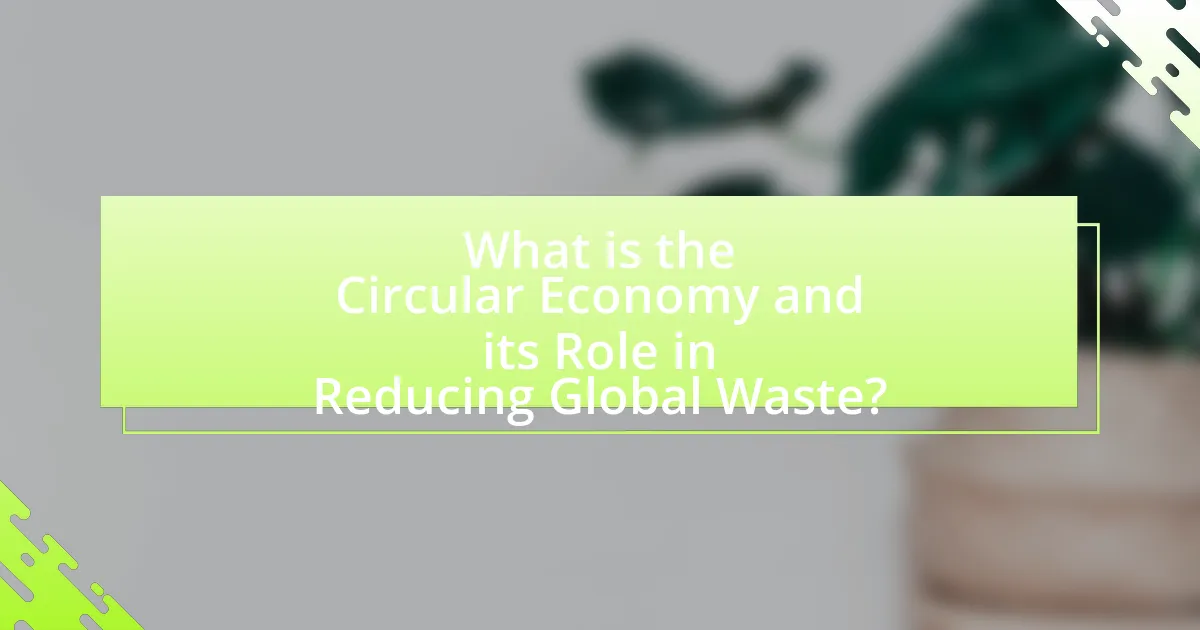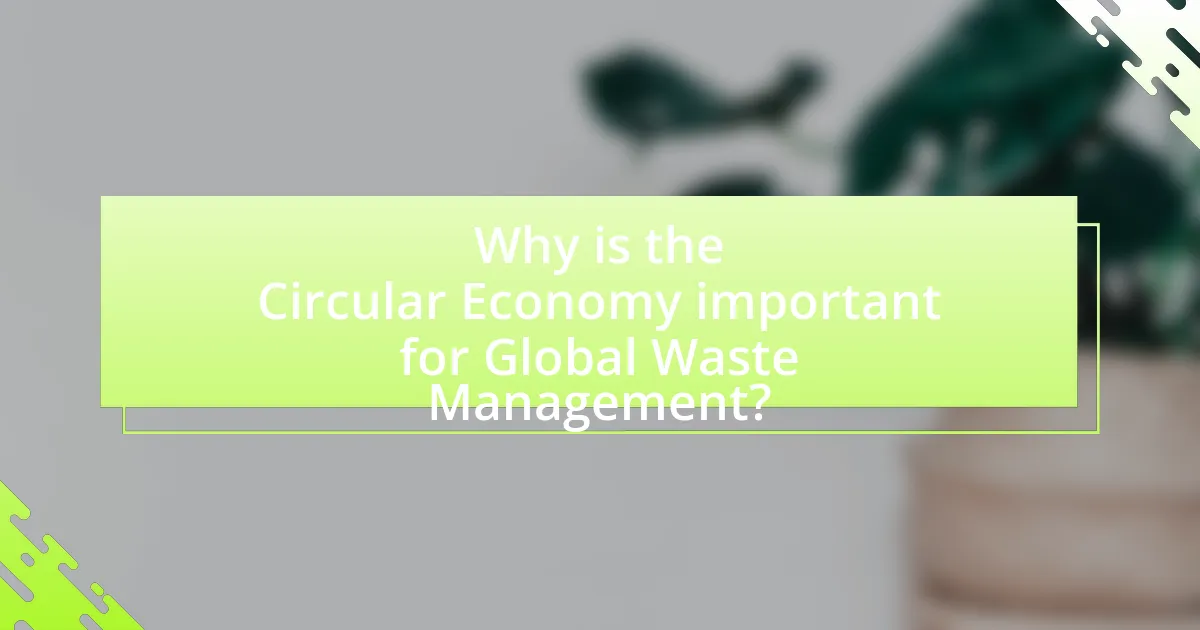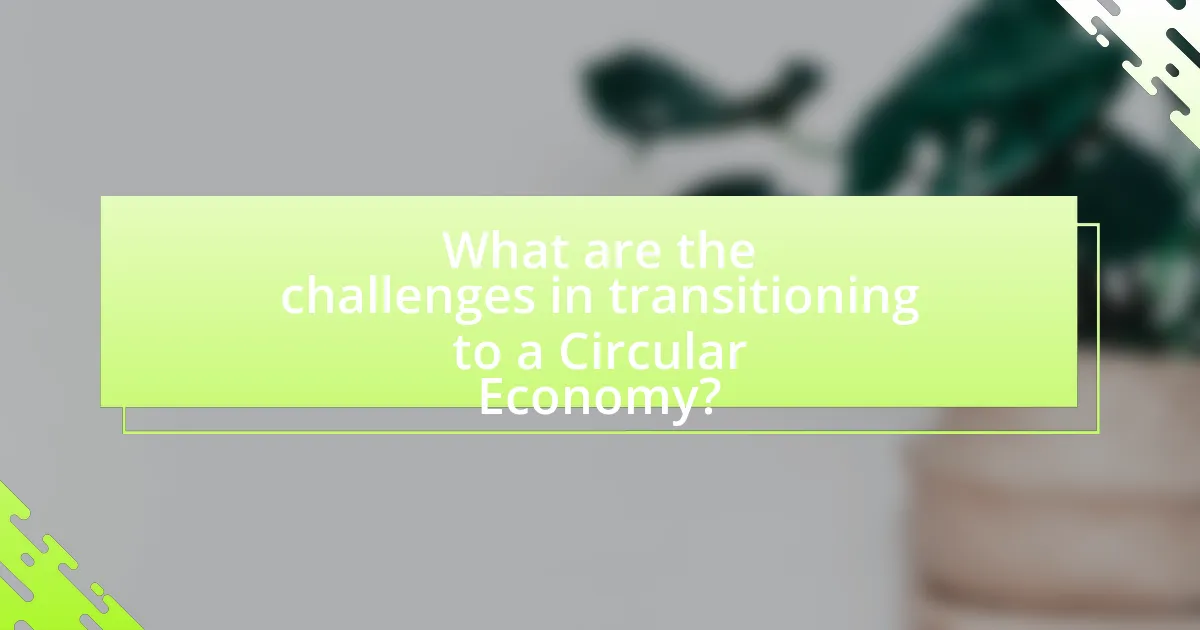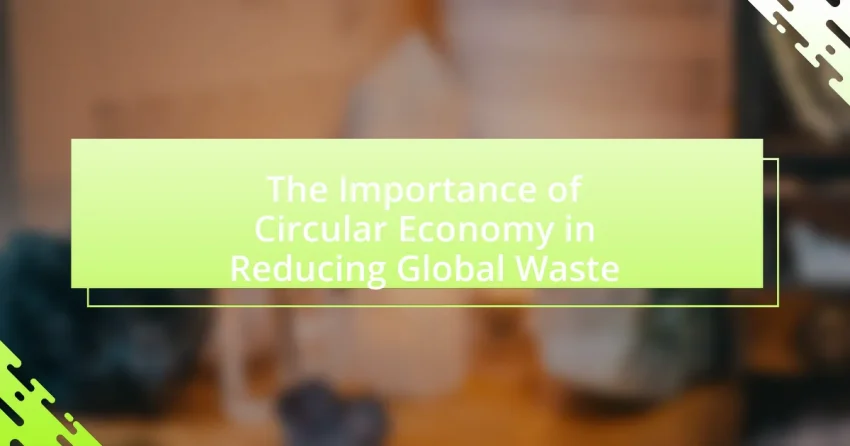The Circular Economy is an economic model designed to minimize waste and maximize resource efficiency through practices such as reuse, recycling, and regeneration of materials. This approach contrasts with the traditional linear economy, which generates excessive waste through a ‘take-make-dispose’ model. Key principles of the Circular Economy include designing products for longevity, maintaining product value, and minimizing waste, all aimed at reducing global waste and environmental impact. The article explores the differences between these economic models, the goals and benefits of adopting a Circular Economy, the challenges faced in its implementation, and the role of consumer behavior and collaboration among stakeholders in promoting sustainable practices.

What is the Circular Economy and its Role in Reducing Global Waste?
The Circular Economy is an economic model aimed at minimizing waste and making the most of resources by promoting the reuse, recycling, and regeneration of materials. This approach contrasts with the traditional linear economy, which follows a ‘take, make, dispose’ pattern, leading to significant waste generation. By implementing practices such as product design for longevity, resource recovery, and sustainable consumption, the Circular Economy can significantly reduce global waste. For instance, a report by the Ellen MacArthur Foundation states that transitioning to a Circular Economy could reduce global greenhouse gas emissions by 39% by 2030, highlighting its potential impact on waste reduction and environmental sustainability.
How does the Circular Economy differ from the Traditional Linear Economy?
The Circular Economy differs from the Traditional Linear Economy in that it emphasizes resource reuse and recycling, while the Linear Economy follows a ‘take-make-dispose’ model. In the Circular Economy, products are designed for longevity, repairability, and recyclability, which minimizes waste and reduces the consumption of finite resources. For instance, according to the Ellen MacArthur Foundation, transitioning to a Circular Economy could reduce global greenhouse gas emissions by 39% by 2030, demonstrating its potential to significantly mitigate environmental impact compared to the Linear Economy’s wasteful practices.
What are the key principles of the Circular Economy?
The key principles of the Circular Economy include designing for longevity, maintaining product value, and minimizing waste. Designing for longevity involves creating products that are durable and can be easily repaired or upgraded, which extends their lifecycle. Maintaining product value focuses on keeping materials in use through reuse, refurbishment, and recycling, thereby reducing the need for new resources. Minimizing waste emphasizes the importance of reducing, reusing, and recycling materials to create a closed-loop system where waste is eliminated. These principles collectively aim to create a sustainable economic model that reduces global waste and conserves resources.
Why is the Linear Economy considered unsustainable?
The Linear Economy is considered unsustainable because it relies on a ‘take-make-dispose’ model that depletes finite resources and generates excessive waste. This model leads to environmental degradation, as natural resources are extracted without regard for their regeneration, resulting in habitat destruction and biodiversity loss. According to the Ellen MacArthur Foundation, the linear approach contributes to over 90% of the world’s biodiversity loss and water stress, highlighting its detrimental impact on ecosystems. Furthermore, the accumulation of waste in landfills and oceans exacerbates pollution and climate change, making the linear model incompatible with long-term sustainability goals.
What are the main goals of implementing a Circular Economy?
The main goals of implementing a Circular Economy are to minimize waste, enhance resource efficiency, and promote sustainable production and consumption practices. By designing products for longevity, reuse, and recycling, the Circular Economy aims to reduce the environmental impact associated with linear consumption models. According to the Ellen MacArthur Foundation, transitioning to a Circular Economy could lead to a reduction of global greenhouse gas emissions by 39% by 2030, demonstrating its potential to significantly mitigate climate change and resource depletion.
How does the Circular Economy aim to minimize waste?
The Circular Economy aims to minimize waste by promoting the continual use of resources through recycling, reusing, and remanufacturing. This model contrasts with the traditional linear economy, which follows a ‘take-make-dispose’ pattern, leading to significant waste generation. By designing products for longevity and facilitating their return to the production cycle, the Circular Economy reduces the volume of waste sent to landfills. For instance, a study by the Ellen MacArthur Foundation highlights that transitioning to a Circular Economy could reduce global greenhouse gas emissions by 39% by 2030, demonstrating its potential impact on waste reduction.
What impact does the Circular Economy have on resource consumption?
The Circular Economy significantly reduces resource consumption by promoting the reuse, recycling, and repurposing of materials. This model minimizes the extraction of new resources, leading to a decrease in environmental degradation and resource depletion. For instance, a study by the Ellen MacArthur Foundation found that transitioning to a circular economy could reduce global material consumption by up to 70% by 2030, thereby conserving natural resources and reducing waste.

Why is the Circular Economy important for Global Waste Management?
The Circular Economy is important for Global Waste Management because it promotes resource efficiency and minimizes waste through the continual use of materials. By designing products for longevity, repairability, and recyclability, the Circular Economy reduces the volume of waste sent to landfills. According to the Ellen MacArthur Foundation, transitioning to a Circular Economy could reduce global greenhouse gas emissions by 39% by 2030, highlighting its potential impact on waste reduction and environmental sustainability.
How does the Circular Economy contribute to environmental sustainability?
The Circular Economy contributes to environmental sustainability by minimizing waste and promoting resource efficiency. This model emphasizes the continual use of resources through recycling, reusing, and refurbishing, which reduces the extraction of raw materials and lowers greenhouse gas emissions. For instance, a study by the Ellen MacArthur Foundation found that transitioning to a Circular Economy could reduce global greenhouse gas emissions by 39% by 2030. By closing the loop of product life cycles, the Circular Economy not only conserves natural resources but also fosters innovation in sustainable practices, ultimately leading to a healthier environment.
What are the environmental benefits of reducing waste through a Circular Economy?
Reducing waste through a Circular Economy significantly decreases environmental pollution and conserves natural resources. This model promotes the reuse and recycling of materials, which leads to lower greenhouse gas emissions; for instance, the Ellen MacArthur Foundation reports that transitioning to a Circular Economy could reduce global carbon emissions by 39% by 2030. Additionally, it minimizes landfill waste, which is a major source of soil and water contamination. By keeping materials in use longer, the Circular Economy also reduces the need for new raw materials, preserving biodiversity and ecosystems.
How does the Circular Economy help in combating climate change?
The Circular Economy helps in combating climate change by promoting resource efficiency and reducing greenhouse gas emissions. This economic model emphasizes the reuse, recycling, and regeneration of materials, which minimizes waste and lowers the demand for new resource extraction. For instance, a study by the Ellen MacArthur Foundation found that transitioning to a Circular Economy could reduce global carbon emissions by 39% by 2030. By keeping products in use longer and designing them for longevity, the Circular Economy significantly decreases the energy consumption associated with manufacturing and disposal, thus directly addressing climate change challenges.
What economic advantages does the Circular Economy provide?
The Circular Economy provides significant economic advantages, including cost savings, job creation, and increased resource efficiency. By minimizing waste and maximizing the use of resources, businesses can reduce operational costs; for instance, a study by the Ellen MacArthur Foundation found that transitioning to a circular model could generate $4.5 trillion in economic benefits by 2030. Additionally, the Circular Economy fosters innovation and new business models, leading to the creation of approximately 1.8 million jobs in the European Union alone by 2030, as reported by the European Commission. This model also enhances competitiveness by promoting sustainable practices that appeal to environmentally conscious consumers, thereby driving demand and market growth.
How can businesses benefit financially from adopting Circular Economy practices?
Businesses can benefit financially from adopting Circular Economy practices by reducing costs associated with resource extraction and waste management. By reusing materials and minimizing waste, companies can lower their operational expenses significantly. For instance, a study by the Ellen MacArthur Foundation found that transitioning to a circular model could generate $4.5 trillion in economic benefits by 2030, primarily through resource efficiency and waste reduction. Additionally, businesses can enhance their brand reputation and customer loyalty by demonstrating sustainability, which can lead to increased sales and market share.
What role does innovation play in the Circular Economy’s economic benefits?
Innovation is crucial in enhancing the economic benefits of the Circular Economy by driving efficiency, reducing costs, and creating new market opportunities. For instance, innovative technologies such as advanced recycling methods and sustainable materials can significantly lower production costs and resource consumption. According to a report by the Ellen MacArthur Foundation, transitioning to a Circular Economy could generate $4.5 trillion in economic benefits by 2030, highlighting the financial potential of innovative practices. Furthermore, businesses that adopt innovative circular strategies often experience increased competitiveness and resilience, as they can adapt to changing consumer demands for sustainability.

What are the challenges in transitioning to a Circular Economy?
The challenges in transitioning to a Circular Economy include technological limitations, economic barriers, and behavioral resistance. Technological limitations arise from the need for advanced recycling processes and sustainable materials that are not yet widely available. Economic barriers involve the initial investment costs and the potential disruption to existing business models that prioritize linear consumption. Behavioral resistance is evident as consumers and businesses may be reluctant to change established habits and practices. According to a report by the Ellen MacArthur Foundation, transitioning to a Circular Economy could generate $4.5 trillion in economic benefits, but achieving this requires overcoming these significant challenges.
What barriers do businesses face in adopting Circular Economy principles?
Businesses face several barriers in adopting Circular Economy principles, including high initial investment costs, lack of consumer demand, and insufficient regulatory support. High initial investment costs deter companies from transitioning to circular models, as they often require significant capital for new technologies and processes. Additionally, a lack of consumer demand for circular products can limit market incentives, making it difficult for businesses to justify the shift. Furthermore, insufficient regulatory support can create uncertainty, as businesses may not receive clear guidelines or incentives to adopt circular practices, hindering their ability to implement sustainable changes effectively.
How can regulatory frameworks support the transition to a Circular Economy?
Regulatory frameworks can support the transition to a Circular Economy by establishing clear guidelines and incentives that promote sustainable practices. These frameworks can mandate recycling, waste reduction, and resource efficiency, thereby encouraging businesses to adopt circular principles. For instance, the European Union’s Circular Economy Action Plan aims to make sustainable products the norm, which includes regulations on product design and waste management. This approach has been shown to reduce landfill waste by 50% in member states, demonstrating the effectiveness of regulatory measures in facilitating a shift towards a Circular Economy.
What role does consumer behavior play in the success of the Circular Economy?
Consumer behavior is crucial for the success of the Circular Economy as it directly influences demand for sustainable products and practices. When consumers prioritize eco-friendly options, businesses are incentivized to adopt circular practices, such as recycling and resource efficiency. For instance, a study by McKinsey & Company found that 70% of consumers are willing to pay more for sustainable products, demonstrating a clear market preference that drives companies to innovate in circularity. This shift in consumer preferences not only reduces waste but also fosters a sustainable economic model that benefits both the environment and businesses.
How can stakeholders collaborate to promote a Circular Economy?
Stakeholders can collaborate to promote a Circular Economy by establishing partnerships that facilitate resource sharing, innovation, and sustainable practices. For instance, businesses can work with local governments to create recycling programs that encourage community participation, while NGOs can educate consumers about sustainable consumption. Research indicates that collaborative initiatives, such as the Ellen MacArthur Foundation’s Circular Economy 100 program, have successfully brought together diverse stakeholders to share best practices and drive systemic change. This collaboration not only enhances resource efficiency but also reduces waste, aligning with the goals of a Circular Economy.
What partnerships are essential for advancing Circular Economy initiatives?
Collaboration between businesses, governments, and non-profit organizations is essential for advancing Circular Economy initiatives. Businesses can innovate and implement sustainable practices, while governments can create supportive policies and regulations. Non-profit organizations can raise awareness and drive community engagement. For example, the Ellen MacArthur Foundation collaborates with various stakeholders to promote circular economy principles, demonstrating the effectiveness of multi-sector partnerships in achieving sustainability goals.
How can education and awareness drive Circular Economy practices?
Education and awareness can significantly drive Circular Economy practices by equipping individuals and organizations with the knowledge needed to understand sustainable resource management. When people are educated about the principles of the Circular Economy, such as reducing waste, reusing materials, and recycling, they are more likely to adopt behaviors that support these practices. For instance, a study by the Ellen MacArthur Foundation highlights that increased awareness can lead to a 20% reduction in waste generation in communities that actively engage in educational programs about sustainability. This demonstrates that informed individuals can make choices that contribute to a more sustainable economy, ultimately reducing global waste.
What practical steps can individuals take to support the Circular Economy?
Individuals can support the Circular Economy by adopting practices such as reducing consumption, reusing products, and recycling materials. By minimizing unnecessary purchases, individuals decrease demand for new products, which in turn reduces resource extraction and waste generation. Reusing items, such as repurposing containers or donating clothes, extends the lifecycle of products and keeps them out of landfills. Recycling materials, including plastics, metals, and paper, ensures that valuable resources are recovered and reintroduced into the production cycle, thereby conserving energy and reducing pollution. According to the Ellen MacArthur Foundation, transitioning to a Circular Economy could reduce global greenhouse gas emissions by 39% by 2030, highlighting the significant impact of individual actions on sustainability.
How can consumers make more sustainable choices in their daily lives?
Consumers can make more sustainable choices in their daily lives by prioritizing products that are eco-friendly, reducing waste, and supporting circular economy practices. For instance, choosing items with minimal packaging, opting for reusable products, and purchasing from companies that implement recycling programs can significantly decrease environmental impact. Research indicates that adopting such behaviors can lead to a reduction in waste generation; for example, the Ellen MacArthur Foundation reports that transitioning to a circular economy could reduce global waste by 70% by 2030.
What are some examples of Circular Economy practices individuals can adopt?
Individuals can adopt several Circular Economy practices, including reducing consumption, reusing items, recycling materials, and participating in sharing economies. Reducing consumption involves buying only what is necessary, which minimizes waste generation. Reusing items extends their life cycle, such as using glass jars for storage instead of purchasing new containers. Recycling materials ensures that products are processed and transformed into new items, thereby conserving resources; for instance, recycling paper can save trees and water. Lastly, participating in sharing economies, such as car-sharing or tool libraries, allows individuals to access goods without the need for ownership, reducing overall demand and waste. These practices collectively contribute to a more sustainable lifestyle and help mitigate global waste issues.
